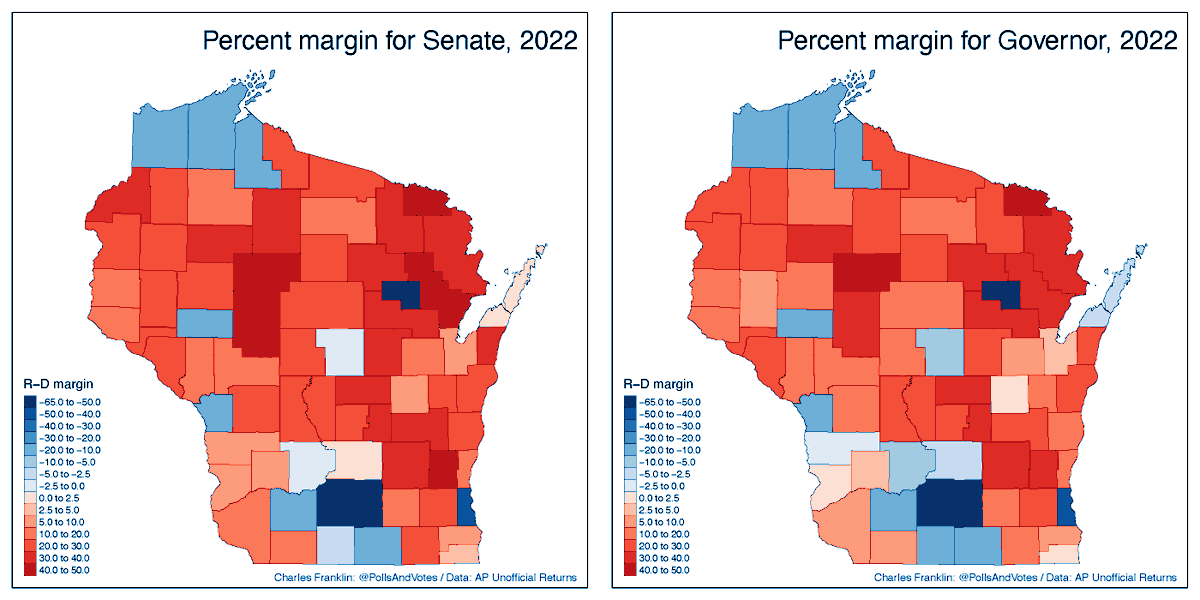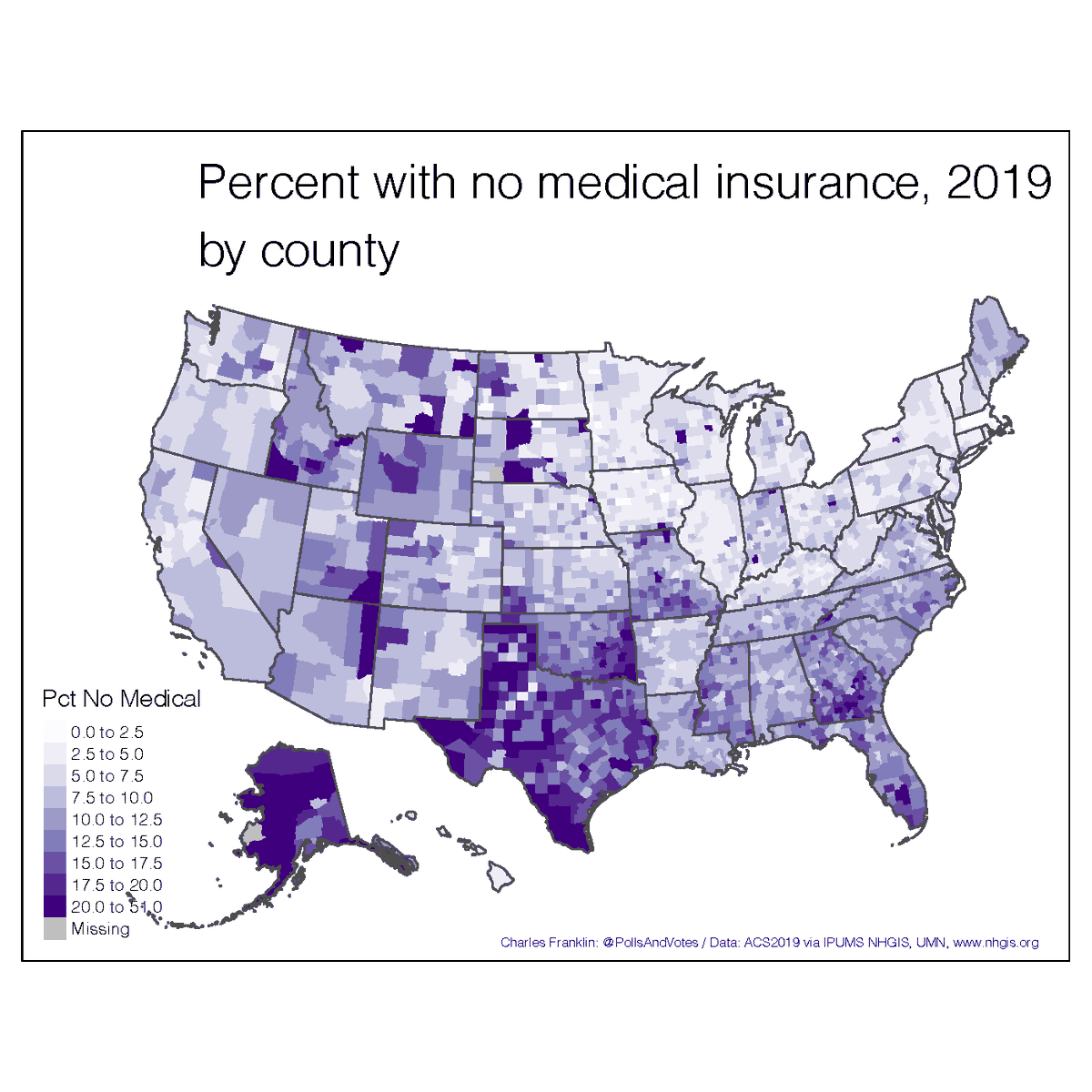
Co-Dev. https://t.co/JD9ObuugSo, https://t.co/Ovy3zGCciZ, Director Marquette Law School Poll, Prof Emeritus UW-Madison. R nerd.
3 subscribers
How to get URL link on X (Twitter) App




 Trump continues to trail Biden, by 10 points in this poll. Biden lead has been increasing since March. DeSantis was a point stronger than Trump vs Biden in March & Sept, but now 10 points stronger on margin vs Biden. 2/n
Trump continues to trail Biden, by 10 points in this poll. Biden lead has been increasing since March. DeSantis was a point stronger than Trump vs Biden in March & Sept, but now 10 points stronger on margin vs Biden. 2/n 

 Do note the places with pop declines though. Milwaukee is important for decline in pop, and as
Do note the places with pop declines though. Milwaukee is important for decline in pop, and as https://twitter.com/BrianTWelsch/status/1591569602580189184notes may account for decline in total vote in 2022.


 Barnes won MKE county by 40.26%, so if turnout had remained at 2018 level, and Barnes got the same share of those additional votes, he would have picked up 18,959 net votes
Barnes won MKE county by 40.26%, so if turnout had remained at 2018 level, and Barnes got the same share of those additional votes, he would have picked up 18,959 net votes

 Now look at shifts since the 2016 Senate and 2018 Gov races.
Now look at shifts since the 2016 Senate and 2018 Gov races.

 The "fundamentals" provide a helpful baseline, even if "non-fundamentals" such as polling, candidate quality, unique issues, may modify that baseline. So let's only look at historical relationships here. 2/n
The "fundamentals" provide a helpful baseline, even if "non-fundamentals" such as polling, candidate quality, unique issues, may modify that baseline. So let's only look at historical relationships here. 2/n

 Nice separation of first 3, then Minuscules of both types come at similar times
Nice separation of first 3, then Minuscules of both types come at similar times

 For tracking individual change we need panel data. Thanks to Democracy Fund and Voter Study Group we have a public panel from 2011 through 2020.
For tracking individual change we need panel data. Thanks to Democracy Fund and Voter Study Group we have a public panel from 2011 through 2020.

https://twitter.com/PostGraphics/status/1446872838443520000Here is 2020 at the municipality level. This is our @MULawPoll & Lubar center mapping app by @jdjmke at lubarcenter.shinyapps.io/VotesApp/ it has statewide results 2000-2020 so you can compare over time. 2/n


 @jdjmke A way to see the geographic clustering is this chart from @jdjmke It shows how many D and R voters live in extremely lopsided neighborhoods (that voted 75-25 or more for the D or R). In 2000 9% of Ds and 2% of Rs lived in such places. Now it is 21% of Ds and 5% of Rs. 2/n
@jdjmke A way to see the geographic clustering is this chart from @jdjmke It shows how many D and R voters live in extremely lopsided neighborhoods (that voted 75-25 or more for the D or R). In 2000 9% of Ds and 2% of Rs lived in such places. Now it is 21% of Ds and 5% of Rs. 2/n 

https://twitter.com/PollsAndVotes/status/1416903618561781776
 Probability vaxed:
Probability vaxed:
 As pct vaccinated rises, the UNvaccinated are increasingly composed of those who are "not very" or "not at all likely" to get vaccinated.
As pct vaccinated rises, the UNvaccinated are increasingly composed of those who are "not very" or "not at all likely" to get vaccinated. 


 Also tl;dr we had more 9-0 or 8-1 decisions this year (67%) than in 2019 (46%) and the average of 48% over the last 10 years. The Justices who agreed LEAST on decisions (Sotomayor and Thomas) nonetheless *agreed* in 61% of decisions. 2/n
Also tl;dr we had more 9-0 or 8-1 decisions this year (67%) than in 2019 (46%) and the average of 48% over the last 10 years. The Justices who agreed LEAST on decisions (Sotomayor and Thomas) nonetheless *agreed* in 61% of decisions. 2/n 

 @WisVoter The list of oddest odd couples is in this @WisVoter tweet. 2/n
@WisVoter The list of oddest odd couples is in this @WisVoter tweet. 2/nhttps://twitter.com/WisVoter/status/1409183564697059333


 OK here are the variables. National Democratic percentage of the 2-party House vote in the midterm by the national 2 party vote in the previous presidential election. Not much of a relationship. Some votes go up (above the diagonal) and about as many go down (below diagonal) 2/n
OK here are the variables. National Democratic percentage of the 2-party House vote in the midterm by the national 2 party vote in the previous presidential election. Not much of a relationship. Some votes go up (above the diagonal) and about as many go down (below diagonal) 2/n 

https://twitter.com/PollsAndVotes/status/1395113103457759236
 Wisconsin had the least uninsured among non-expansion states prior to expansion beginning in 2014, has improved, and remains lowest of the no-expansion states.
Wisconsin had the least uninsured among non-expansion states prior to expansion beginning in 2014, has improved, and remains lowest of the no-expansion states.

https://twitter.com/MollyBeck/status/1395110776793452545
 Wisc coverage compares favorably with many other states, and especially so among those that also declined to expand Medicaid
Wisc coverage compares favorably with many other states, and especially so among those that also declined to expand Medicaid


 And here are deaths per million.
And here are deaths per million.


 One puzzle is why cases are correlated but deaths are not. I don't have an answer to that, but it is interesting.
One puzzle is why cases are correlated but deaths are not. I don't have an answer to that, but it is interesting.